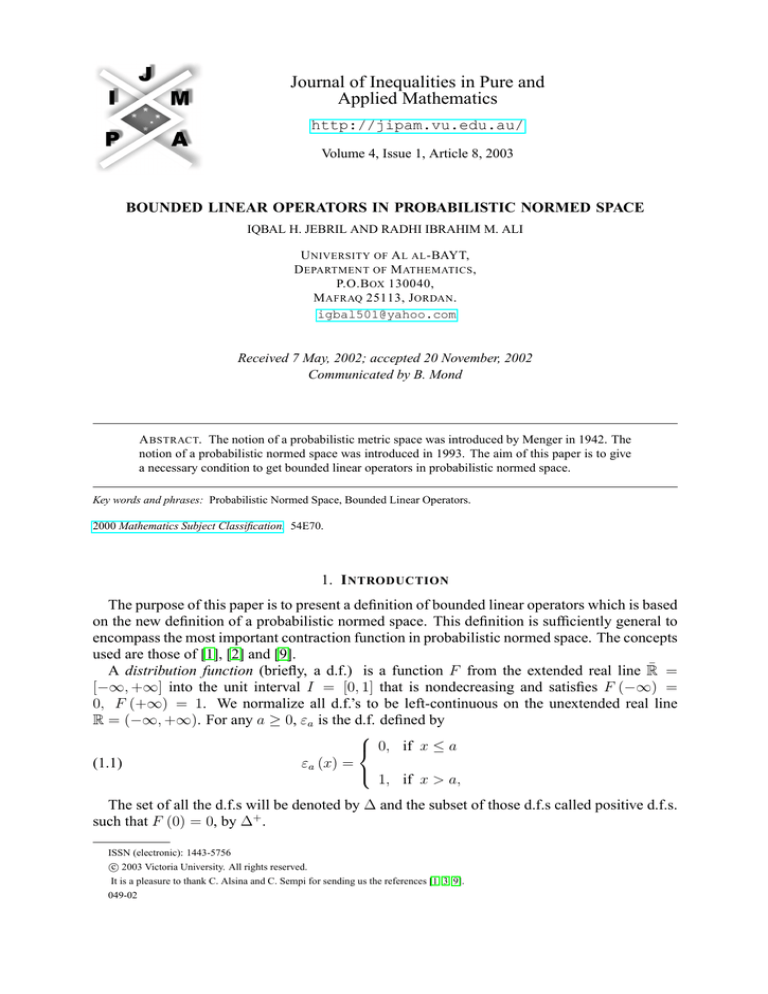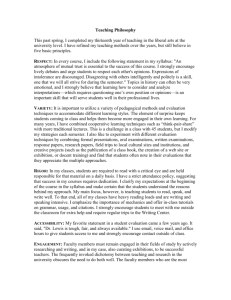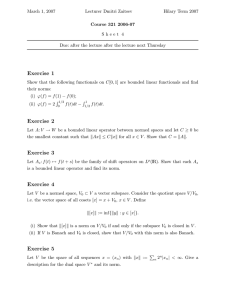
Journal of Inequalities in Pure and
Applied Mathematics
http://jipam.vu.edu.au/
Volume 4, Issue 1, Article 8, 2003
BOUNDED LINEAR OPERATORS IN PROBABILISTIC NORMED SPACE
IQBAL H. JEBRIL AND RADHI IBRAHIM M. ALI
U NIVERSITY OF A L AL -BAYT,
D EPARTMENT OF M ATHEMATICS ,
P.O.B OX 130040,
M AFRAQ 25113, J ORDAN .
igbal501@yahoo.com
Received 7 May, 2002; accepted 20 November, 2002
Communicated by B. Mond
A BSTRACT. The notion of a probabilistic metric space was introduced by Menger in 1942. The
notion of a probabilistic normed space was introduced in 1993. The aim of this paper is to give
a necessary condition to get bounded linear operators in probabilistic normed space.
Key words and phrases: Probabilistic Normed Space, Bounded Linear Operators.
2000 Mathematics Subject Classification. 54E70.
1. I NTRODUCTION
The purpose of this paper is to present a definition of bounded linear operators which is based
on the new definition of a probabilistic normed space. This definition is sufficiently general to
encompass the most important contraction function in probabilistic normed space. The concepts
used are those of [1], [2] and [9].
A distribution function (briefly, a d.f.) is a function F from the extended real line R̄ =
[−∞, +∞] into the unit interval I = [0, 1] that is nondecreasing and satisfies F (−∞) =
0, F (+∞) = 1. We normalize all d.f.’s to be left-continuous on the unextended real line
R = (−∞, +∞). For any a ≥ 0, εa is the d.f. defined by
0, if x ≤ a
(1.1)
εa (x) =
1, if x > a,
The set of all the d.f.s will be denoted by ∆ and the subset of those d.f.s called positive d.f.s.
such that F (0) = 0, by ∆+ .
ISSN (electronic): 1443-5756
c 2003 Victoria University. All rights reserved.
It is a pleasure to thank C. Alsina and C. Sempi for sending us the references [1, 3, 9].
049-02
2
I QBAL H. J EBRIL AND R ADHI I BRAHIM M. A LI
By setting F ≤ G whenever F (x) ≤ G (x) for all x in R, the maximal element for ∆+ in
this order is the d.f. given by
0, if x ≤ 0,
ε0 (x) =
1, if x > 0.
A triangle function is a binary operation on ∆+ , namely a function τ : ∆+ ×∆+ → ∆+ that is
associative, commutative, nondecreasing and which has ε0 as unit, that is, for all F, G, H ∈ ∆+ ,
we have
τ (τ (F, G) , H) = τ (F, τ (G, H)) ,
τ (F, G) = τ (G, F ) ,
τ (F, H) ≤ τ (G, H) ,
if F ≤ G,
τ (F, ε0 ) = F.
Continuity of a triangle function means continuity with respect to the topology of weak convergence in ∆+ .
Typical continuous triangle functions are convolution and the operations τT and τT ∗ , which
are, respectively, given by
τT (F, G) (x) = sup T (F (s) , G (t)) ,
(1.2)
s+t=x
and
τT ∗ (F, G) (x) = inf T ∗ (F (s) , G (t)) ,
(1.3)
s+t=x
+
for all F, G in ∆ and all x in R [9, Sections 7.2 and 7.3], here T is a continuous t-norm, i.e. a
continuous binary operation on [0, 1] that is associative, commutative , nondecreasing and has
1 as identity; T ∗ is a continuous t-conorm, namely a continuous binary operation on [0, 1] that
is related to continuous t-norm through
(1.4)
T ∗ (x, y) = 1 − T (1 − x, 1 − y) .
It follows without difficulty from (1.1)–(1.4) that
τT (εa , εb ) = εa+b = τT ∗ (εa , τb ) ,
for any continuous t-norm T , any continuous t-conorm T ∗ and any a, b ≥ 0.
The most important t-norms are the functions W , P rod, and M which are defined, respectively, by
W (a, b) = max (a + b − 1, 0) ,
prod (a, b) = a · b,
M (a, b) = min (a, b) .
Their corresponding t-norms are given, respectively, by
W ∗ (a, b) = min (a + b, 1) ,
prod∗ (a, b) = a + b − a · b,
M ∗ (a, b) = max (a, b) .
Definition 1.1. A probabilistic metric (briefly PM) space is a triple (S, f, τ ), where S is a
nonempty set, τ is a triangle function, and f is a mapping from S × S into ∆+ such that, if Fpq
denoted the value of f at the pair (p, q), the following hold for all p, q, r in S:
(PM1) Fpq = ε0 if and only if p = q.
J. Inequal. Pure and Appl. Math., 4(1) Art. 8, 2003
http://jipam.vu.edu.au/
B OUNDED
LINEAR
O PERATORS
3
(PM2) Fpq = Fqp .
(PM3) Fpr ≥ τ (Fpq , Fqr ) .
Definition 1.2. A probabilistic normed space is a quadruple (V, ν, τ, τ ∗ ), where V is a real
vector space, τ and τ ∗ are continuous triangle functions, and ν is a mapping from V into ∆+
such that, for all p, q in V , the following conditions hold:
(PN1) νp = ε0 if and only if p = θ, θ being the null vector in V ;
(PN2) ν−p = νp ;
(PN3) νp+q ≥ τ (νp , νq )
(PN4) νp ≤ τ ∗ ναp , ν(1−α)p for all α in [0, 1].
If, instead of (PN1), we only have νθ = εθ , then we shall speak of a Probabilistic Pseudo
Normed Space, briefly a PPN space. If the inequality (PN4) is replaced by the equality Vp =
τM ναp , ν(1−α)p , then the PN space is called a Serstnev space. The pair is said to be a Probabilistic Seminormed Space (briefly PSN space) if ν : V → ∆+ satisfies (PN1) and (PN2).
Definition 1.3. A PSN (V, ν) space is said to be equilateral if there is a d.f. F ∈ ∆+ different
from ε0 and from ε∞ , such that, for every p 6= θ, νp = F. Therefore, every equilateral PSN
space (V, ν) is a PN space under τ = M and τ ∗ = M where is the triangle function defined for
G, H ∈ ∆+ by
M (G, H) (x) = min {G (x) , H (x)}
(x ∈ [0, ∞]) .
An equilateral PN space will be denoted by (V, F, M ) .
Definition 1.4. Let (V, k·k) be a normed space and let G ∈ ∆+ be different from ε0 and ε∞ ;
define ν : V → ∆+ by νθ = ε0 and
t
(p 6= θ, t > 0) ,
νp (t) = G
kpkα
where α ≥ 0. Then the pair (V, ν) will be called the α−simple space generated by (V, k·k) and
by G.
The α−simple space generated by (V, k·k) and by G is immediately seen to be a PSN space;
it will be denoted by (V, k·k , G; α).
Definition 1.5. There is a natural topology in PN space (V, ν, τ, τ ∗ ), called the strong topology;
it is defined by the neighborhoods,
Np (t) = {q ∈ V : νq−p (t) > 1 − t} = {q ∈ dL (νq−p , ε0 ) < t} ,
where t > 0. Here dL is the modified Levy metric ([9]).
2. B OUNDED L INEAR O PERATORS IN P ROBABILISTIC N ORMED S PACES
In 1999, B. Guillen, J. Lallena and C. Sempi [3] gave the following definition of bounded set
in PN space.
Definition 2.1. Let A be a nonempty set in PN space (V, ν, τ, τ ∗ ). Then
(a) A is certainly bounded if, and only if, ϕA (x0 ) = 1 for some x0 ∈ (0, +∞);
(b) A is perhaps bounded if, and only if, ϕA (x0 ) < 1 for every x0 ∈ (0, +∞) and
l− ϕA (+∞) = 1;
(c) A is perhaps unbounded if, and only if, l− ϕA (+∞) ∈ (0, 1);
(d) A is certainly unbounded if, and only if, l− ϕA (+∞) = 0; i.e., ϕA (x) = 0;
where ϕA (x) = inf {νp (x) : P ∈ A} and l− ϕA (x) = lim ϕA (t).
t→x−
Moreover, A will be said to be D-bounded if either (a) or (b) holds.
Definition 2.2. Let (V, ν, τ, τ ∗ ) and (V 0 , µ, σ, σ ∗ ) be PN spaces. A linear map T : V → V 0 is
said to be
J. Inequal. Pure and Appl. Math., 4(1) Art. 8, 2003
http://jipam.vu.edu.au/
4
I QBAL H. J EBRIL AND R ADHI I BRAHIM M. A LI
(a) Certainly bounded if every certainly bounded set A of the space (V, ν, τ, τ ∗ ) has, as
image by T a certainly bounded set T A of the space (V 0 , µ, σ, σ ∗ ), i.e., if there exists
x0 ∈ (0, +∞) such that νp (x0 ) = 1 for all p ∈ A, then there exists x1 ∈ (0, +∞) such
that µT p (x1 ) = 1 for all p ∈ A.
(b) Bounded if it maps every D-bounded set of V into a D-bounded set of V 0 , i.e., if, and
only if, it satisfies the implication,
lim ϕA (x) = 1 ⇒ lim ϕT A (x) = 1,
x→+∞
x→+∞
for every nonempty subset A of V .
(c) Strongly B-bounded if there exists
a constant k > 0 such that, for every p ∈ V and for
x
every x > 0, µT p (x) ≥ νp k , or equivalently if there exists a constant h > 0 such
that, for every p ∈ V and for every x > 0,
µT p (hx) ≥ νp (x) .
(d) Strongly C-bounded if there exists a constant h ∈ (0, 1) such that, for every p ∈ V and
for every x > 0,
νp (x) > 1 − x ⇒ µT p (hx) > 1 − hx.
Remark 2.1. The identity map I between PN space (V, ν, τ, τ ∗ ) into itself is strongly Cbounded. Also, all linear contraction mappings, according to the definition of [7, Section 1],
are strongly C-bounded, i.e for every p ∈ V and for every x > 0 if the condition νp (x) > 1 − x
is satisfied then
νIp (hx) = νp (hx) > 1 − hx.
But we note that when k = 1 then the identity map I between PN space (V, ν, τ, τ ∗ ) into
itself is a strongly B-bounded operator. Also, all linear contraction mappings, according to the
definition of [9, Section 12.6], are strongly B-bounded.
In [3] B. Guillen, J. Lallena and C. Sempi present the following, every strongly B-bounded
operator is also certainly bounded and every strongly B-bounded operator is also bounded. But
the converses need not to be true.
Now we are going to prove that in the Definition 2.2, the notions of strongly C-bounded
operator, certainly bounded, bounded and strongly B-bounded do not imply each other.
In the following example we will introduce a strongly C-bounded operator, which is not
strongly B-bounded, not bounded nor certainly bounded.
Example 2.1. Let V be a vector space and let νθ = µθ = ε0 , while, if p, q 6= θ then, for every
p, q ∈ V and x ∈ R, if
1
3, x ≤ 1
0, x ≤ 1
9
, 1<x<∞
νp (x) =
µp (x) =
10
1, x > 1
1, x = ∞
and if
τ (νp (x) , νq (y)) = τ ∗ (νp (x) , νq (y)) = min (νp (x) , νq (x)) ,
σ (µp (x) , µq (y)) = σ ∗ (µp (x) , µq (y)) = min (µp (x) , µq (x)) ,
then (V, ν, τ, τ ∗ ) and (V 0 , µ, σ, σ ∗ ) are equilateral PN spaces by Definition 1.3. Now let I :
(V, ν, τ, τ ∗ ) → (V, µ, τ, τ ∗ ) be the identity operator, then I is strongly C-bounded but I is
not strongly B-bounded, bounded and certainly bounded, it is clear that I is not certainly
J. Inequal. Pure and Appl. Math., 4(1) Art. 8, 2003
http://jipam.vu.edu.au/
B OUNDED
LINEAR
O PERATORS
5
bounded and
1isnot bounded. I is not strongly B-bounded, because for every k > 0 and for
x = max 2, k ,
9
µIp (kx) =
< 1 = νp (x) .
10
But I is strongly C-bounded, because for every p > 0 and for every x > 0, this condition
7
vp (x) > 1 − x is satisfied only if x > 1 now if h = 10
x then
7
7
1
3
7
7
µIp (hx) = µIp
x = µp
= >
=1−
=1−
x.
10x
10
3
10
10
10x
Remark 2.2. We have noted in the above example that there is an operator, which is strongly
C-bounded, but it is not strongly B-bounded. Moreover we are going to give an operator, which
is strongly B-bounded, but it is not strongly C-bounded.
Definition 2.3. Let (V, ν, τ, τ ∗ ) be PN space then we defined
B (p) = inf h ∈ R : νp h+ > 1 − h .
Lemma 2.3. Let T : (V, ν, τ, τ ∗ ) → (V 0 , µ, σ, σ ∗ ) be a strongly B-bounded linear operator, for
every p in V and let µT p be strictly increasing on [0, 1], then B (Tp ) < B (p) , ∀p ∈ V.
Proof. Let η ∈ 0, 1−γ
B
(p)
, where γ ∈ (0, 1). Then B (p) > γ [B (p) + η] and so
γ
µT p (B (p)) > µT p (γ [B (p) + η]) ,
and where µT p is strictly increasing on [0, 1], then
µT p (γ [B (p) + η]) ≥ νp (B (p) + η) ≥ νp B (p)+ > 1 − B (p) ,
we conclude that
B (Tp ) = inf B (p) : µT p B (p)+ > 1 − B (p) ,
so B (Tp ) < B (p) , ∀p ∈ V.
Theorem 2.4. Let T : (V, ν, τ, τ ∗ ) → (V 0 , µ, σ, σ ∗ ) be a strongly B-bounded linear operator,
and let µT p be strictly increasing on [0, 1], then T is a strongly C-bounded linear operator.
Proof. Let T be a strictly B-bounded operator. Since, by Lemma 2.3, B (Tp ) < B (p) , ∀p ∈ V
there exist γp ∈ (0, 1) such that B (Tp ) < γp B (p).
It means that
inf h ∈ R : µT p h+ > 1 − h ≤ γ inf h ∈ R : νp h+ > 1 − h
= inf γh ∈ R : νp h+ > 1 − h
+
h
h
= inf h ∈ R : νp
>1−
.
γ
γ
We conclude that νp hγ > 1 − hγ =⇒ µT p (h) > 1 − h. Now if x = hγ then νp (x) >
1 − x =⇒ µT p (xh) > 1 − xh, so T is a strongly C-bounded operator.
Remark 2.5. From Theorem 2.4 we have noted that under some additional condition every a
strongly B-bounded operator is a strongly C-bounded operator. But in general, it is not true.
J. Inequal. Pure and Appl. Math., 4(1) Art. 8, 2003
http://jipam.vu.edu.au/
6
I QBAL H. J EBRIL AND R ADHI I BRAHIM M. A LI
0
Example 2.2.
Let
V = V =
Rand v0 = µ0 = ε0 , while, if p 6= 0, then, for x > 0, let
x
x
vp (x) = G |p| , µp (x) = U |p|
, where
1
1
2 , 0 < x ≤ 2,
2 , 0 < x ≤ 32 ,
G (x) =
U (x) =
.
3
1, 2 < x ≤ +∞,
1, 2 < x ≤ +∞
Consider now the identity map I : (R, |·| , G, µ) → (R, |·| , G, µ). Now
(a) I is a strongly B-bounded operator, such that for every p ∈ R and every x > 0 then
1 , 0 < x ≤ 2 |p| ,
2
3
3
3x
x
µIp
x = µp
x =U
=
=G
= vp (x) .
4
4
4 |p|
|p|
1, 2 |p| < x ≤ +∞,
3
, p = 14 .
(b) I is not a strongly C-bounded operator, such that for every h ∈ (0, 1), let x = 8h
If x > 2 |p| then the condition vp (x) > 1 − x will be satisfied, but we note that
hx
3
1
5
3
µIp (hx) = µp (hx) = U
=U
= < =1−h
= 1 − hx.
|p|
2
2
8
8h
Now we introduce the relation between the strongly B-bounded and strongly C-bounded
operators with boundedness in normed space.
Theorem 2.6. Let G be strictly increasing on [0, 1], then T : (V, k·k , G, α) → (V 0 , k·k , G, α)
is a strongly B-bounded operator if, and only if, T is a bounded linear operator in normed
space.
Proof. Let k > 0 and x > 0. Then for every p ∈ V
x
kx
G
= µT p (kx) ≥ vp (x) = G
,
kTp kα
kpkα
if and only if
1
kTp k ≤ k α kpk .
Theorem 2.7. Let T : (V, k·k , G, α) → (V 0 , k·k , G, α) be strongly C-bounded, and let G be
strictly increasing on [0, 1] then T is a bounded linear operator in normed space.
Proof. If vp is strictly increasing for every p ∈ V , then the quasi-inverse vpΛ is continuous and
B (p) is the unique solution of the equation x = vpΛ (1 − x) i.e.
B (p) = vpΛ (x) (1 − B (p)) .
(2.1)
If vp (x) = G
(2.2)
x
kpkα
, then vpΛ (x) = kpkα GΛ (x) and from (2.1) it follows that
B (p) = kpkα GΛ (1 − B (p)) .
Suppose that T is strongly C-bounded, i.e. that
(2.3)
B (Tp ) ≤ kB (p) , ∀p ∈ V,
where k ∈ (0, 1) .
Then (2.2) and (2.3) imply
B (Tp )
kB (p)
kB (p)
kTp kα ≤ Λ
≤ Λ
≤ Λ
= k kpkα .
G (1 − B (Tp ))
G (1 − kB (p))
G (1 − B (p))
Which means that T is a bounded in normed space.
J. Inequal. Pure and Appl. Math., 4(1) Art. 8, 2003
http://jipam.vu.edu.au/
B OUNDED
LINEAR
O PERATORS
7
The converse of the above theorem is not true, see Example 2.2.
We recall the following theorems from [3].
Theorem 2.8. Let (V, ν, τ, τ ∗ ) and (V 0 , µ, σ, σ ∗ ) be PN spaces. A linear map T : V → V 0 is
either continuous at every point of V or at no point of V .
Corollary 2.9. If T : (V, ν, τ, τ ∗ ) → (V 0 , µ, σ, σ ∗ ) is linear, then T is continuous if, and only if,
it is continuous at θ.
Theorem 2.10. Every strongly B-bounded linear operator T is continuous with respect to the
strong topologies in (V, ν, τ, τ ∗ ) and (V 0 , µ, σ, σ ∗ ), respectively.
In the following theorem we show that every strongly C-bounded linear operator T is continuous.
Theorem 2.11. Every strongly C-bounded linear operator T is continuous.
Proof. Due to Corollary 3.1 [3], it suffices to verify that T is continuous at θ. Let Nθ0 (t), with
t > 0, be an arbitrary neighbourhood of θ0 . If T is strongly C-bounded linear operator then
there exist h ∈ (0, 1) such that for every t > 0 and p ∈ Nθ (s) we note that
µT p (t) ≥ νp (ht) ≥ 1 − ht > 1 − t,
so Tp ∈ Nθ0 (t); in other words, T is continuous.
R EFERENCES
[1] C. ALSINA, B. SCHWEIZER AND A. SKLAR, On the definition of probabilistic normed space,
Aequationes Math., 46 (1993), 91–98.
[2] C. ALSINA, B. SCHWEIZER, C. SEMPI AND A. SKLAR, On the definition of a probabilistic
inner product space, Rendiconti di Mathematica, 17 (1997), 115–127.
[3] B. GUILLEN, J. LALLENA AND C. SEMPI, A study of boundedness in probabilistic normed
spaces, J. Math. Anal. Appl., 232 (1999), 183–196.
[4] B. GUILLEN, J. LALLENA AND C. SEMPI, Probabilistic norms for linear operators, J. Math.
Anal. Appl., 220 (1998), 462–476.
[5] B. GUILLEN, J. LALLENA AND C. SEMPI, Some classes of probabilistic normed spaces, Rendiconti di Mathematica, 17(7) (1997), 237–252.
[6] E. KREYSZIG, Introductory Functional Analysis with Applications, John Wiley and Sons Inc.New
York, 1978.
[7] E. PAP AND O. HADZIC, A fixed point theorem in probabilistic metric spaces and application, J.
Math. Anal. Appl., 202 (1996), 433–449.
[8] B. SCHWEIZER AND A. SKIAR, Statistical metric space, Pacific J. Math., 10 (1960), 313–334.
[9] B. SCHWEIZER AND A. SKIAR, Probabilistic Metric Space, Elsevier North Holland New York,
1983.
[10] R. TARDIFF, Topologies for probabilistic metric spaces, Pacific J. Math., 65 (1976), 233–251.
[11] A. TAYLOR, Introduction to Functional Analysis, John Wiley and Sons Inc., New York, 1958.
J. Inequal. Pure and Appl. Math., 4(1) Art. 8, 2003
http://jipam.vu.edu.au/





